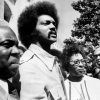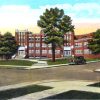calsfoundation@cals.org
Private School Movement
aka: Segregation Academies
Beginning in the mid-1960s and continuing into the early 1970s, there was a rapid expansion in the establishment of new, non-parochial private schools across the South. This phenomenon, often called the “segregation academy” or “white academy” movement, was commonly viewed as a means for white parents to avoid having their children attend increasingly integrated public schools. Within Arkansas, the establishment of new private schools was concentrated in two areas—the Delta region and Pulaski County. Starting in the mid-1960s, both of these areas, which had the highest concentration of African Americans in the state, truly began to integrate their schools. The resulting increased level of integration provided the impetus for the start of the private school movement in Arkansas, which was most prolific from 1966 to 1972.
Delta Region
The private school movement in Arkansas first appeared in the Delta counties. The first school founded was Marvell Academy in Marvell (Phillips County), which opened in 1966 with seventy-three students. Most of the school’s board of directors were members of the local pro-segregation Citizens’ Council. The next new private schools were not established until 1968, when Southeast Academy in Gould (Lincoln County) opened with 113 students and Calvary Christian School opened in Forrest City (St. Francis County) with about fifty students. In 1969, Lee Academy in Marianna (Lee County) was founded with twenty-five students. The Warren Academy in Warren (Bradley County) started in 1969 with forty-two students.
The year 1970 saw a sharp increase in the establishment of new schools in this region. These included Bayou Park Academy in McGehee (Desha County) with thirty-five students, Bellaire Academy in Bellaire (Chicot County) with seventy-five enrolled, DeSoto School in Helena (Phillips County) with 250 pupils, England Academy in England (Lonoke County) with 185 enrolled, Monroe Academy in Wheatley (St. Francis County) with seventy-five students, Montrose Academy in Montrose (Ashley County) with 125 students, and Nathan Bedford Forrest Academy in Forrest City with 148 students; the last of these was also associated with the local Citizens’ Council. Two schools were founded in West Memphis (Crittenden County) in 1970: Tabernacle Baptist Academy with 200 students and Central Baptist School with 115 students.
Four schools were founded in 1971 in this region, two of which were located in Pine Bluff (Jefferson County). Jefferson Academy opened with 201 students, and Watson Chapel Academy opened with 199 students. In Hughes (St. Francis County), the Hughes Academy opened, after many children in the area had been bused to Memphis, Tennessee; West Memphis; Marvell; and Marianna to attend other private schools. West Memphis Christian Academy, after offering only a kindergarten in 1970, began offering some primary grades in 1971. The opening of these schools was largely the end of the private school movement’s establishment in the Delta counties.
Pulaski County
The private school movement was more active in Pulaski County than in any other single county in Arkansas and was largely a response to the introduction of “forced busing.” The first private school to appear was Northside Academy in North Little Rock (Pulaski County) in 1969 (seventy enrolled), which was followed by Victory Baptist School in Sherwood (Pulaski County) in 1970 (150 enrolled). In 1971, three schools opened: Edgewood Academy in North Little Rock (fifty-five enrolled), Central Arkansas Christian School in the Sylvan Hills area in what is now Sherwood (146 enrolled), and Pulaski Academy in Little Rock (Pulaski County) (218 enrolled). In 1972, Heritage Christian School (296 enrolled) and Park Place Baptist Academy (36 enrolled) started, both in Little Rock.
In addition to the completely new private schools, several schools that were originally kindergarten-only schools expanded to offer primary grades. From 1970 to 1972, the Roper School, Miss Selma’s School, Darnell School, Little Rock Montessori, North Little Rock Montessori, and Stanton Road School all began offering various elementary grades.
Other Areas
Only one such school was founded in the rest of the state by 1972. In 1969, the Center Hill School relocated from Texas to Searcy (White County) and had only a handful of students. Although not in Arkansas, the Liberty School in Texarkana, Texas, which started in 1969, did enroll some students from the Arkansas side of the state line.
Black Private Schools
A few all-black private schools were also started during this era, which may be described as “boycott schools” due to their origins. In 1970, the black residents of College Station (Pulaski County) formed the Freedom School, which had a peak enrollment of about 300. This school, which existed for only a little over two weeks, was founded during a school boycott to protest what was believed to be an unfair busing plan. Black citizens of Wabbaseka (Jefferson County) organized the Black Movement School in 1970, which enrolled some 200 students. This school was formed during a school boycott protesting the firing of some black teachers. The school closed in January 1971 after the situation in Wabbaseka had been resolved. The black students of Earle (Crittenden County) began boycotting the schools there in 1970 to protest what they believed was the biased treatment of certain teachers and continuing discriminatory practices. Following attacks upon unarmed African Americans in an event that came to be called the Earle Race Riot of 1970, the protestors organized the Soul Institute, which enrolled about 390 students. Apparently, the Soul Institute remained in operation for the remainder of the school term. One other all-black school, the Shiloh Seventh-Day Adventist School, opened in 1972 in Little Rock with fifty-five students. It is not known if the start of this school had any connection to desegregation issues, however.
Public Support
Unlike in some other states in the South, Arkansas never provided any public support for its private schools during these years, although some efforts were made to do so. A bill was introduced in the Arkansas House of Representatives in 1967 that proposed to allow a city, county, or school district to appropriate funds to provide financial assistance for children attending private schools. The bill was then withdrawn. In 1971, the state House and Senate both passed a bill that allowed public school teachers who transferred to private schools to continue to participate in the state’s teacher retirement system. Governor Dale Bumpers vetoed the bill. In 1973, an amendment was attached to a proposal to increase retirement benefits for public school teachers that again proposed to allow private school teachers to participate in the state’s teacher retirement system. This amendment was not approved, however.
Characteristics
The private school movement in Arkansas was typical of the larger movement across the South. The buildings these schools used varied considerably, including several converted homes, a hotel, a medical clinic, closed public school buildings, and an old automobile agency building. Other schools used their church’s education building, and some used portable classrooms. A few schools were able to erect completely new facilities. Tuition ranged from $350 per student per year to over $1,000. Other costs were often added, such as one school requiring a $50 enrollment fee and another a $1,000 mandatory building fund contribution. Many of the teachers in these schools were either retired or former public school teachers. The curriculum offered was usually limited, and educational aids and extracurricular activities were often lacking or absent. Some of the schools were open about the fact that they enrolled only white students. Some stated that they would consider admitting black students at a later time, and some, at least officially, had open admissions policies. It would not be until the mid-1970s that black students began to enroll in these new schools, and then only in small numbers.
Summary
From 1966 to 1972, at least thirty-five new, non-parochial private schools were established in Arkansas, including the expanded kindergartens and black boycott schools. While it is not possible to determine the exact enrollment in these schools, a reasonable estimate is possible. In 1968, the total enrollment was around 313, and it stood at 3,450 in 1970. The enrollment for 1972 is less certain, but a rough estimate is 5,000. In addition to the schools that actually did begin operation, there were several failed efforts. Plans to start schools in El Dorado (Union County), Eudora (Chicot County), Little Rock, Burdette (Mississippi County), Pine Bluff, and Altheimer (Jefferson County) all fell through.
The lifespan of these schools varied. Due to a lack of adequate finances and insufficient enrollment, several of the new private schools had short lives. For example, the Warren Academy and the Northside Academy closed in 1972; both operated for only three years. Edgewood Academy, after scaling back its program, finally closed in 1979. Several of the schools established from 1966 to 1972, were, however, able to survive and are still in operation today. For example, the DeSoto School, Pulaski Academy, Jefferson Academy, Central Arkansas Christian School, and Marvell Academy continue to operate in the twenty-first century.
For additional information:
Cleghorn, Reese. “Segregation Academies: The Old South Tries Again.” Saturday Review, May 16, 1970.
Egerton, John. “Seg Academies, with Much Church Aid, Flourish in South, as Other Private Schools Wane.” South Today, September, 1973.
Gladney, Margaret Rose. “I’ll Take My Stand: The Southern Segregation Academy Movement.” PhD diss., University of New Mexico, 1974.
Griffith, Kitty. “‘Segregation Academies’ Flourish in South.” South Today, October 1969.
Leeson, Jim. “Private Schools Continue to Increase in the South.” Southern Education Report, November 1966.
———. “Private Schools for Whites Face Some Hurdles.” Southern Education Report, October 1969.
Nevin, David, and Robert E. Bills. The Schools that Fear Built: Segregationist Academies in the South. Washington DC: Acropolis Books, 1976.
“Segregation Academies and State Action.” Yale Law Journal 82 (June 1973): 1436–1461.
Stewart, Jeffery. “The Private School Movement in Pulaski County, 1969–1979.” Pulaski County Historical Review 64 (Winter 2016): 122–137.
Stratton, Dotty. “Public vs. Private Schools in Arkansas: A New Color-Coded Education May Be Turning Back the Clock.” Arkansas Times, May 1981, pp. 22–27.
Terjen, Kitty. “Close-Up on Segregation Academies.” New South, Fall 1972.
———. “White Flight: The Segregation Academy Movement.” In The South and Her Children: School Desegregation, 1970–71, edited by Robert E. Anderson. Atlanta: Southern Regional Council, 1971.
Walden, John C., and Allen D. Cleveland. “The South’s New Segregation Academies.” Phi Delta Kappan 53 (December 1971): 234–235, 238–239.
‘‘White Academies’ in the South—Booming Despite Obstacles.” U.S. News & World Report, April 19, 1971.
Jeffery Stewart
Little Rock, Arkansas








Comments
No comments on this entry yet.